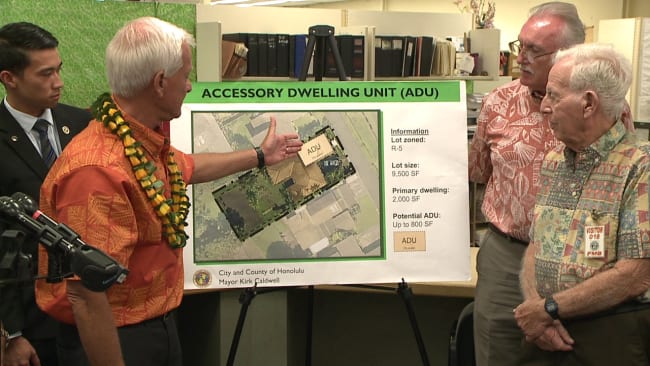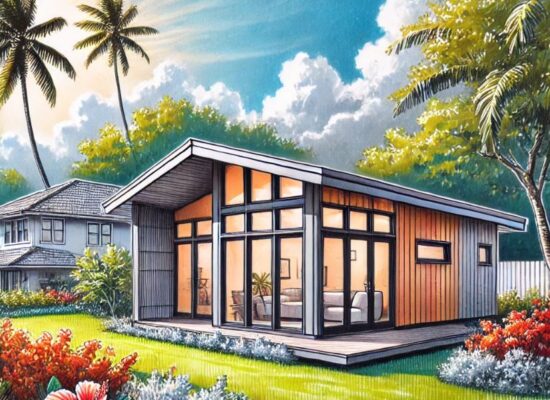- How to Optimize Space In Your New ADU
- Just How Big is a 400 sq ft ADU?
- What is an Accessory Dwelling Unit?
- What’s the 411 with Hawaii ADUs?
- What’s the 411 with Hawaii ADU’s: The FAQs Continued
- The Benefits of Building an ADU on Your Property
- Why Are ADUs So Important in Hawaii?
- Why ADUs Make Financial Sense
- Six Questions to Ask Yourself Before You Build an ADU in Hawaii
- The 9 Basic Requirements for Building an ADU in Hawaii
- Retirement Downsizing in Place with an Accessible ADU
A QUICK GUIDE TO BUILD A SECOND UNIT ON YOUR LOT
What Is An Accessory Dwelling Unit?
An Accessory Dwelling Unit (ADU) is a second dwelling unit, including its own kitchen, bedroom, and bathroom facilities. It may be attached or detached from the primary dwelling unit on the zoning lot. ADUs are intended to be “accessory” to the primary dwelling and are typically much smaller.
This new law allows homeowners to build and rent a second home on their property.
It could be attached or detached. It could be the garage. But small kine, not large, where it becomes unaffordable. ~ Kirk Caldwell, Mayor of Honolulu
Benefits of Accessory Dwelling Units
- An increasing number of communities across the nation are allowing Accessory Dwelling Units (ADU), also known as granny flats and second units, within residential areas to increase their affordable housing supply.
- ADUs offer a variety of benefits to communities. They create housing options that support workforce housing, provide flexible living arrangements for multigenerational families, and provide supplemental income for homeowners.
- ADUs also support sustainability because they are often conversions of underutilized space and consume less land than new single-family development on vacant land.
- Elderly and/or disabled persons who may want to live close to family members or caregivers, empty nesters, and young adults, find ADUs convenient and affordable.
- As identified in the Affordable Housing Strategy, there is a major shortage of affordable housing on Oahu, especially for rental housing. ADUs can help address this problem by allowing existing homeowners to build or convert a legal second unit on their property.
- The ADU Ordinance was signed into law on September 14, 2015, by Mayor Kirk Caldwell. The purpose of this Ordinance is to allow ADUs as a permitted use in Residential and Country zoning districts to encourage and accommodate the construction of ADUs, which will increase the number of affordable rental units and help ease the housing shortage in the City.
I would like to keep my dad home with me. That’s why I’m doing it. You forget about the hidden homeless. There’s many hidden homeless members in our community. ~ Kahaunani Mahoe-Theone, ADU applicant

PROCEDURE TO ADD AN ADU
1. Decide what type of ADU fits your needs.
2. Check if you meet the basic requirements.
3. Complete the Ohana/ADU Public Facilities Pre-check Form.
4. Prepare construction drawings.
5. Apply for a building permit.
A. WHAT TYPE OF ADU TO BUILD
An ADU can be attached or detached from the main dwelling. There are several ways by which an ADU can be added to a lot:
- Addition to or alteration of an existing structure.
- Construction of a new structure.
- Recognition of an existing structure that was built without a building permit.
- Conversion of an existing structure that exceeds the maximum floor area and/or cannot offer the least off-street parking (Zoning Adjustment required).
B. ADU BASIC REQUIREMENTS
Prior to applying for a building permit, check if the basic requirements to adapt, build, or convert an ADU on a lot are met.
This ordinance is the most significant affordable housing ordinance the city’s adopted in years. ~ Ron Menor, Honolulu City Councilman
BASIC REQUIREMENTS*
- The lot is zoned: R-3.5, R-5, R-7.5, R-10, R-20 or Country District.
- Minimum lot area of 3,500 SF
- The lot is not landlocked.
- The lot does not have more than one dwelling unit, i.e., more than one single-family dwelling, two-family dwelling, accessory ohana dwelling, guest house, multi-family dwelling, planned development housing, cluster, or group living facility.
- Either the main dwelling or the ADU will be occupied by the property owner(s), the owner’s family, or a designated authorized representative.
- The owner(s) of the lot will record covenants running with the land with the Bureau of Conveyances or the Land Court of the State of Hawaii, or both, as is appropriate.
- Private covenants do not prohibit ADUs.
- The lot can fit one parking space in addition to the parking required for the primary dwelling unit. No parking is required if the lot is located within one-half mile of a rail transit station.
- Floor area maximum: 400 SF (for lots with an area of 3,500 to 4,999 SF) and 800 SF (for lots with an area of 5,000 SF or more).
* For more detailed information, see Ordinance 15-41.
There are three possible outcomes:
Outcome 1: If you meet all the requirements, proceed to C.
Outcome 2: If you do not meet any of requirements 1 to 7, you cannot build an ADU on your lot.
Outcome 3: If you are converting an existing structure into an ADU, AND you meet requirements 1 to 7, but do not meet either 8 or 9 or both, apply for a Zoning Adjustment (refer to E). Once the Zoning Adjustment is approved, proceed to Section C.
C. APPLYING FOR A BUILDING PERMIT
After completing the Ohana/ADU Public Facilities Pre-Check Form (refer to E); there are two ways to apply for a building permit. New buildings must be filed electronically through ePlans. Alterations or additions may submit a hard copy application.
D. PERTINENT FORMS AND INSTRUCTIONS
Listed below are pertinent forms and other important information that is needed to adapt, build, or convert an ADU.
- Ohana/ADU Public Facilities Pre-Check Form
- Internet Building Permit Application
- Basic Requirements Information about lot size and zoning district.
- Access to ePlans
- Zoning Adjustment Information for preparing and applying for a Zoning Adjustment: ADU Application Instructions
- Restrictive Covenant Sample draft of a restrictive covenant. Restrictive Covenant Sample
After a building permit is issued and construction of an ADU is underway, inspectors will inspect the building, electrical work, and plumbing. Once your inspection is completed, the Certificate of Occupancy will be issued.
This web page is a general guide, please consult each county agency for other details and/or the latest amendments and changes.
For more detailed information, visit the Honolulu Department of Planning and Permitting website,
All information is subject to change. Revised September 2015
Sep 14, 2015 – Accessory Dwelling Units: The ADU Ordinance was signed into law on September 14, 2015, by Mayor Kirk Caldwell. The purpose of this Ordinance is to allow ADUs as a permitted use in Residential and Country
zoning districts and to encourage and accommodate construction of ADUs, which will increase the number of affordable rental units and help ease the housing shortage in the City. Following are Bill 20 (2015) CD1, ADU informational documents, Ohana/ADU Pre-Check Form and Director’s report.
- Ordinance 15-41
- ADU Quick guide to build an ADU on your lot
- ADU Frequently Asked Questions (FAQ)
- Ohana/ADU Public Facilities Pre-Check
Form - Director’s Report
 Copyright secured by Digiprove
Copyright secured by Digiprove 



